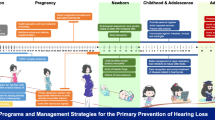Abstract
The objective was to examine processes leading to the diagnosis of hearing loss in children. The subjects were 328 children (hearing loss >30 dB HL) fitted with hearing aids in Helsinki University Central Hospital. The risk factor initiated hearing loss detection in 31%, whereas parental suspicion accounted for 26% and hearing screening at the well-baby clinics for 20% of the subjects. Parents were foremost to suspect hearing loss at the age spoken language normally emerges (1.5–3.4 years). Screening was equally effective irrespective of the severity of hearing loss. Parents with misgivings of hearing impairment in their child should have compliant access to audiological units.


Similar content being viewed by others
References
Chalmers D, Stewart E, Mulvena A (1989) Otitis media with effusion in children. The Dunedin study. Clinics in developmental medicine no 108. MacKeith Press, Oxford
Dalzell L, Orlando M, MacDonald M, Berg A, Bradley M, Cacace A, Campbell D, Decristofaro J, Gravel J, Greenberg E, Gross S, Pinheiro J, Regan J, Spivak L, Stevens F, Prieve B (2000) The New York state universal newborn hearing screening demonstration project: ages of hearing identification, hearing aid fitting, and enrollment in early intervention. Ear Hear 21:118–130
Delb W, Merkel D, Pilorget K, Schmitt J, Plinkert PK (2004) Effectiveness of a TEOAE-based screening program. Can a patient-tracking system effectively be organized using modern information technology and central data management? Eur Arch Otorhinolaryngol 261:191–196
de Maddalena H, Reich K, Arold R (1997) Significance of parental variables on early detection of pediatric hearing loss. Results of a retrospective survey of parents with hearing-impaired children. HNO 45:30–35
Doyle KJ, Burggraaff B, Fujikawa S, Kim J (1997) Newborn hearing screening by otoacoustic emissions and automated auditory brainstem response. Int J Pediatr Otorhinolaryngol 41:111–119
Elden LM, Potsic WP (2002) Screening and prevention of hearing loss in children. Curr Opin Pediatr 14:723–730
Feinmesser M, Tell L, Levi H (1982) Follow-up of 40,000 infants screened for hearing defect. Audiology 21:197–203
Haggard RS, Primus MA (1999) Parental perceptions of hearing loss classification in children. Am J Audiol 8:83–92
Hergils L, Hergils A (2000) Universal neonatal hearing screening—parental attitudes and concern. Br J Audiol 34:321–327
Hirsch A (1988). Hearing loss and associated handicaps in preschool children. Scand Audiol [Suppl 30]:61–64
Jakubicova J, Kabatova Z, Zavodna M (2003) Identification of hearing loss in newborns by transient otoacoustic emissions. Int J Pediatr Otorhinolaryngol 67:15–18
Jauhiainen T, Karikoski JO, Marttila TI (1998) The predominant mode of communication-oral or sign -as an outcome measure of rehabilitation in hearing impaired children. In: Ruben RJ, Karma P (eds) Advances in pediatric otorhinolaryngology. Proceedings of the 7th International Congress of Pediatric Otorhinolaryngology June 7–10, Helsinki, Finland. Elsevier, CD-ROM
Kankkunen A (1982). Pre-school children with impaired hearing. Acta Otolaryngol [Suppl (Stockh) 391]:1–124
Kuhl PK, Williams KA, Lacerda F, Stevens KN, Lindblom B (1992) Linguistic experience alters phonetic perception in infants by 6 months of age. Science 255:606–608
Kvaerner KJ, Arnesen AT (1994) Hearing impairment in Oslo born children 1989–1991. Incidence, etiology and diagnostic delay. Scand Audiol 23:233–239
Martin JAM, Bentzen O, Colley JRT, Hennebert D, Holm C, Iurato S, deJonge A, McCullen O, Meyer ML, Moore WJ, Morgan A (1981) Childhood deafness in the European Community. Scand Audiol 10:165–174
Marttila TI (1986) Results of audiometrical screening in Finnish schoolchildren. Int J Pediatr Otorhinolaryngol 11:39–46
Marttila TI, Karikoski JO (1996) Identification of childhood hearing-impairment in Uusimaa County, Finland. Int J Pediatr Otorhinolaryngol 34:45–51
Mäki-Torkko E (1998) Childhood hearing-impairments and hearing screening. Thesis. Acta Universitatis Ouluensis, Oulu
Parving A (1982) Etiologisk udredning ved høretab hos børn. Nor Med 97:17–19
Parving A (1983) Epidemiology of hearing loss and aetiological diagnosis of hearing impairment in childhood. Int J Pediatr Otorhinolaryngol 5:151–165
Parving A (1984). Early detection and identification of congenital/early acquired hearing disability. Who takes the initiative? Int J Pediatr Otorhinolaryngol 7:107–117
Parving A, Christensen B (1992) Children younger than 4 years of age, referred to an audiological department. Int J Pediatr Otorhinolaryngol 23:161–170
Parving A, Salomon G (1996) The effect of neonatal universal hearing screening in a health surveillance perspective—a controlled study of two health authority districts. Audiology 35:158–168
Robertson C, Aldridge S, Jarman F, Saunders K, Poulakis Z, Oberkleid F (1995). Late diagnosis of congenital sensorineural hearing impairment: why are detection methods failing? Arch Dis Child 72:11–15
Sorri M, Hartikainen-Sorri A, Alho O (1987) Suomen Lääkärilehti (in Finnish) 27:2502–2506
Straaten HL, Groote ME, Oudesluys-Murphy AM (1996) Evaluation of an automated auditory brainstem response in hearing screening method in at risk neonates. Eur J Pediatr 155:702–705
The European consensus development conference on neonatal hearing screening (Milan) (1998). Eur Arch Otorhinolaryngol 255:521–522
Watkin PM, Baldwin M, Laoide S (1990) Parental suspicion and identification of hearing impairment. Arch Dis Child 65:846–850
Vesterager V, Parving A (1995) Rehabilitation of hearing-impaired children: Intervention and outcome. Audiology 34:207–217
World Health Organization (1991) Grades of hearing-impairment. Network News, no 1
Yoon PJ, Price M, Gallagher K, Fleisher BE, Messner AH (2003) The need for long-term audiologic follow-up of neonatal intensive care unit (NICU) graduates. Int J Pediatr Otorhinolaryngol 67:353–357
Yoshinaga-Itano C, Sedey AL, Coulter DK, Mehl AL (1998) Language of early and later-identified children with hearing loss. Pediatrics 102:1161–1171
Author information
Authors and Affiliations
Corresponding author
Rights and permissions
About this article
Cite this article
Marttila, T.I., Karikoski, J.O. Initiators in processes leading to hearing loss identification in Finnish children. Eur Arch Otorhinolaryngol 262, 975–978 (2005). https://doi.org/10.1007/s00405-005-0945-y
Received:
Accepted:
Published:
Issue Date:
DOI: https://doi.org/10.1007/s00405-005-0945-y




